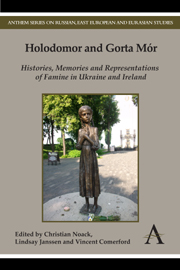Book contents
- Frontmatter
- Contents
- List of Figures
- Acknowledgements
- Introduction Holodomor and Gorta Mór: Histories, Memories and Representations of Famine in Ukraine and Ireland
- Part I Histories, Historiography and Politics
- Chapter 1 Holodomor in Ukraine 1932–1933: An Interpretation of Facts
- Chapter 2 Ethnic Issues in the Famine of 1932–1933 in Ukraine
- Chapter 3 Grievance, Scourge or Shame? The Complexity of Attitudes to Ireland's Great Famine
- Part II Public Commemoration
- Part III Trauma and Victimisation
- Part IV New Sources and New Approaches to the Irish and Ukrainian Famines
- Index
Chapter 2 - Ethnic Issues in the Famine of 1932–1933 in Ukraine
from Part I - Histories, Historiography and Politics
Published online by Cambridge University Press: 05 May 2013
- Frontmatter
- Contents
- List of Figures
- Acknowledgements
- Introduction Holodomor and Gorta Mór: Histories, Memories and Representations of Famine in Ukraine and Ireland
- Part I Histories, Historiography and Politics
- Chapter 1 Holodomor in Ukraine 1932–1933: An Interpretation of Facts
- Chapter 2 Ethnic Issues in the Famine of 1932–1933 in Ukraine
- Chapter 3 Grievance, Scourge or Shame? The Complexity of Attitudes to Ireland's Great Famine
- Part II Public Commemoration
- Part III Trauma and Victimisation
- Part IV New Sources and New Approaches to the Irish and Ukrainian Famines
- Index
Summary
For independent Ukraine, no event has greater significance in the history of the developing nation state than the Famine of 1932–33. It brought about a period of intensive suffering on a hitherto unimagined scale. Although the Famine is becoming integrated into Ukraine's new national history, its progress to that status has been uneven, littered with public disputes and political dissension, and with no consensus among the Ukrainian public as to its scale or, especially, its origins. In part these disputes illustrate the continuing relevance of the Soviet period to life in Ukraine, despite the material and practical steps taken in forging an independent state. The Famine has also generated an emotional academic debate in the West, and no consensus has resulted thus far.2 Ironically, the social and economic historians who have worked most extensively on this period and published their results are much closer to the former late-Soviet perspective that emerged after the earlier period of silence on the Famine. They conclude that it was namely a result of environmental or climatic conditions rather than part of an official state policy aimed at eliminating Ukrainians as a nation.
- Type
- Chapter
- Information
- Holodomor and Gorta MórHistories, Memories and Representations of Famine in Ukraine and Ireland, pp. 35 - 50Publisher: Anthem PressPrint publication year: 2012
- 1
- Cited by



